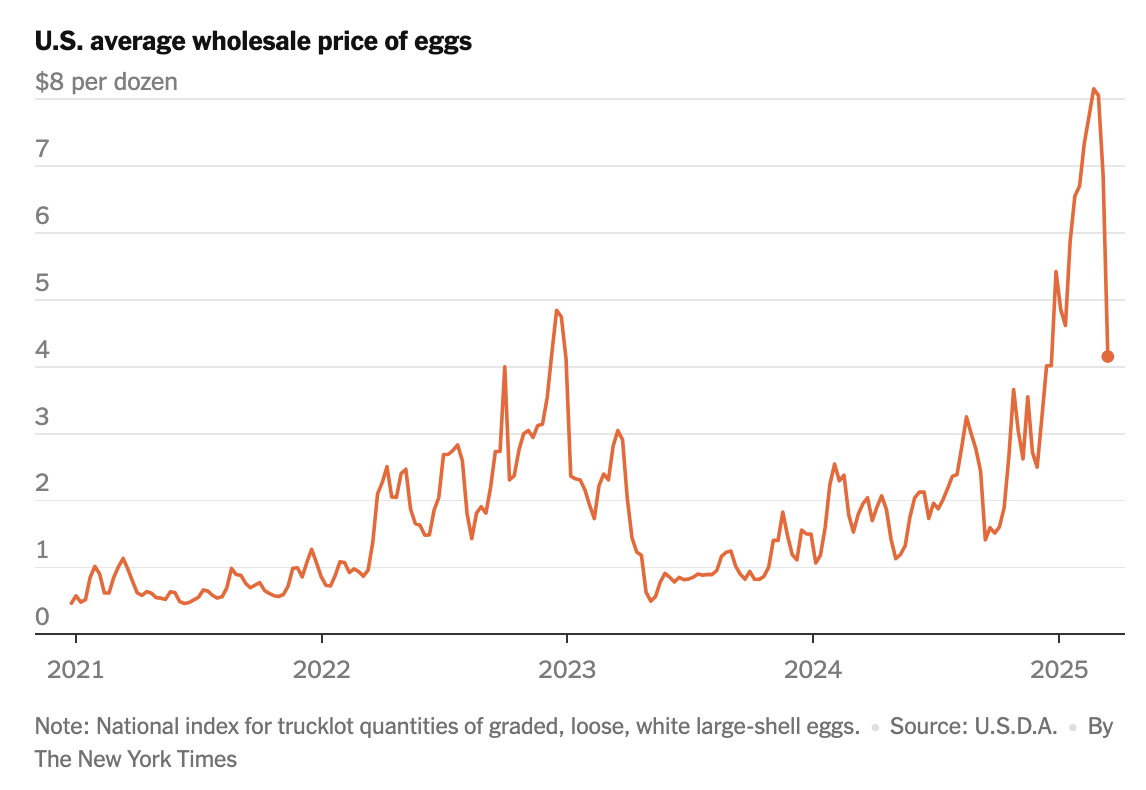Sign up for our newsletter to receive these emails in your inbox.
Egg prices are coming down
US wholesale egg prices have fallen by more than half since their peak in February.

That is welcome news. Still, we should note that from a historical perspective, egg prices were never really that high.
Economist and Human Progress board member Gale Pooley has calculated that in 1919, it took unskilled workers in the United States 12 minutes to earn the money to buy a single egg. In February, when a dozen eggs cost over eight dollars, an unskilled worker could buy one with 2.4 minutes of work.
Remember that we are in the middle of a bird flu pandemic! Between December and February, US egg producers culled 44 million hens to curb the disease, and eggs were still five times more abundant than a century ago. That’s worth considering the next time someone questions the “resilience” of industrial agriculture.
Drones could assist Sherpas on Mount Everest
The New York Times reports that a Nepalese startup called AirLift has begun testing delivery drones above Mount Everest. The quadcopters, which can carry up to 35 pounds at Everest’s altitudes, could transport food, equipment, and garbage up and down the mountain.
The main beneficiaries may be Sherpas, who often haul this stuff themselves—and sometimes die doing it:
Goods that would normally take seven hours to be transported by foot from Everest’s base camp to Camp I can be airlifted within 15 minutes. By lightening the Sherpas’ burdens, drone operators hope that the chances of fatal accidents—which have risen as climate change has accelerated snowmelt—can now be reduced.
A remarkable example of automation improving workplace safety!
Once-yearly lenacapavir injection could prevent HIV
Lenacapavir is a cutting-edge antiretroviral that made headlines in 2024 for preventing HIV with a twice-yearly injection.
Now, a recently published study suggests that new formulations of the drug could function similarly with just a single annual injection.
In the study, researchers compared blood samples of participants injected with the once-yearly formulations with blood samples from trials of the earlier twice-yearly formulation. The new formulations produced higher levels of the drug over the entire 56-week period.

Gilead is planning a larger trial of the new formulations to further test their effectiveness, and whether the drug remains safe at the much higher doses required. If successful, the result would be a much more practical version of an already groundbreaking medicine, especially in regions with poor health infrastructure.
Economics & Development:
- Global Trade Hits Record $33 Trillion in 2024
- Vast Undersea Tunnel Will Change the Road and Rail Map of Europe
Energy & Environment:
- Wolves Make a Rapid Recovery in Europe
- Amazon Expands Use of In-House AI Tools to Reduce Energy Use
- Did Shale Gas Green the US Economy?
- Exciting Black Rhino Recovery Potential for the Future
Health & Demographics:
- Mutated DNA Restored to Normal in Gene Therapy Advance
- Patients with Long COVID Regain Senses with Pioneering Surgery
- Data Suggest Once-Yearly Shot of Prep Drug Blocks HIV Infection
- Young Americans Are Getting Happier
- Swirling Sound Waves Used to Rip Apart Kidney Stones
- Experimental Antifungal Compound Kills Multidrug-Resistant Fungi
- New Treatment May Delay Alzheimer’s Symptoms, Research Continues
Science & Technology:
- In a First, Webb Telescope Directly Observes Exoplanet CO2
- Astronomers Discover 128 New Moons Orbiting Saturn
- Google Releases an AI Model Designed to Identify Wildlife
- Subsea Fibre Cables Can “Listen Out” for Sabotage
- BYD’s 5-Minute 400km EV Charging Breakthrough
